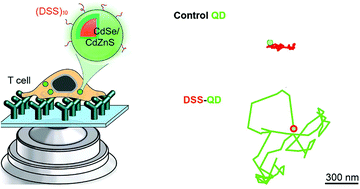Cytosolic delivery of membrane-penetrating QDs into T cell lymphocytes: implications in immunotherapy and drug delivery†
Abstract
We report single-particle characterization of membrane-penetrating semiconductor quantum dots (QDs) in T cell lymphocytes. We functionalized water-soluble CdSe/CdZnS QDs with a cell-penetrating peptide composed of an Asp-Ser-Ser (DSS) repeat sequence. DSS and peptide-free control QDs displayed concentration-dependent internalization. Intensity profiles from single-particle imaging revealed a propensity of DSS-QDs to maintain a monomeric state in the T cell cytosol, whereas control QDs formed pronounced clusters. Single-particle tracking showed a direct correlation between individual QD clusters’ mobility and aggregation state. A significant portion of control QDs colocalized with an endosome marker inside the T cells, while the percentage of DSS-QDs colocalized dropped to 9%. Endocytosis inhibition abrogated the internalization of control QDs, while DSS-QD internalization only mildly decreased, suggesting an alternative cell-entry mechanism. Using 3D single-particle tracking, we captured the rapid membrane-penetrating activity of a DSS-QD. The ability to characterize membrane penetrating activities in live T cells creates inroads for the optimization of gene therapy and drug delivery through the use of novel nanomaterials.



 Please wait while we load your content...
Please wait while we load your content...